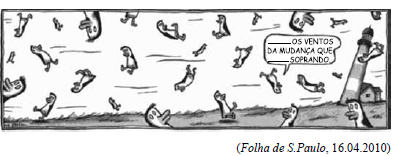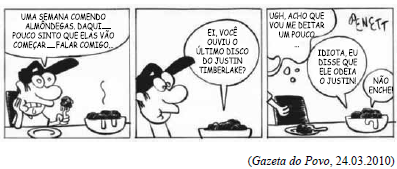Questões Militares
Foram encontradas 17.253 questões
Resolva questões gratuitamente!
Junte-se a mais de 4 milhões de concurseiros!
Leilão da usina de Belo Monte marca mais uma etapa numa polêmica de três décadas; quem é contra acredita numa “virada”
(O Estado de S.Paulo, 25.04.2010)
A construção da usina de Belo Monte tem provocado grandes discussões entre técnicos e ecologistas. Essa usina será construída no rio
A ficção científica em 3D se tornou, no início de 2010, o filme com maior bilheteria do mundo na história do cinema, superando os 2 bilhões de dólares arrecadados. A superprodução futurista foi dirigida por James Cameron o mesmo cineasta de “Titanic”, e que até agora ostentava o título de maior bilheteria com uma arrecadação de 1,843 bilhão de dólares.
(http://oglobo.globo.com/cultura/mat/2010/01/31/)
A notícia refere-se ao filme
Após quatro anos de atividades, o Google anunciou, no dia 22 de março de 2010, que não aceitaria mais a censura imposta às buscas de usuários no site. A decisão do Google de encerrar as atividades do serviço de busca neste país, em razão da censura imposta pelo governo à internet, resulta de um embate entre gigantes que deve alterar as relações de poder no mundo globalizado.
(http://educacao.uol.com.br/atualidades/censura-internet.jhtm)
O país a que se refere a notícia é
(O Estado de S.Paulo, 28.04.2010)
O principal motivo da crise na Grécia e nos demais países citados é
Analise a imagem para responder à questão.

Leia as afirmações sobre a Revolução de 1930 e a Era Vargas.
I. A emergência da classe média, do tenentismo e do movimento operário contribuiu para a vitória da Revolução de 1930.
II. Estados da Federação, insatisfeitos especialmente com a hegemonia de São Paulo, associados a setores econômicos, como charqueadores, produtores de açúcar, de cacau e segmentos industriais, contribuíram para derrubar o Estado oligárquico.
III. Em 1937, Vargas fechou o Congresso Nacional, instalou o Estado Novo e passou a governar com poderes ditatoriais. O governo passou a ser centralizado e o Departamento de Imprensa e Propaganda atuou na linha de frente da censura.
IV. Entre as realizações da Era Vargas pode-se destacar: a criação da Justiça do Trabalho, do salário-mínimo, da Consolidação das Leis do Trabalho, além de obras na área de infraestrutura como a Companhia Siderúrgica Nacional.
Estão corretas as afirmações

Os espaços da frase devem ser preenchidos, correta e respectivamente,
com

Os espaços no primeiro quadrinho da tira devem ser preenchidos,
correta e respectivamente, com